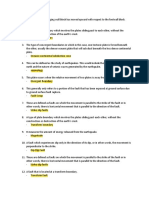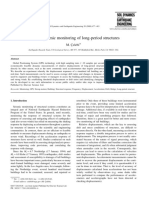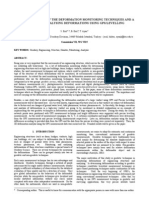Assignment 1
Uploaded by
Peng TerAssignment 1
Uploaded by
Peng TerProblem 1 (20 points)
GPS receivers are attached to the ground and the data is recorded using a
network of a network of satellites around the earth. Since GPS receivers do not
move unless the ground moves, they can be used to track continental drift. Some
of that data can be found on the following website: http://sideshow.jpl.nasa.
gov/post/series.html
Looking at the boundary of the Pacific and North Americal Plates that occurs
along the coast of California, chose a few data points on either side of the
boundary and plot vectors from movement between 2006 and 2012. How much
has each plate moved? From the movement, what can you say about the type of
plate boundary?
Problem 2 (30 points)
Determine the principle stresses and directions for the following stress tensors:
a.
b.
c.
18
0
= 0 50
24
0
24
0
32
3
10
0
0
30
= 10
0
30 27
2
= 1
1
1
0
1
1
1
2
Work (a) and (b) by hand for practice. You can use a computer to solve (c) if
you wish.
You might also like
- Plate Boundaries With Major Strike-Slip Components.No ratings yetPlate Boundaries With Major Strike-Slip Components.11 pages
- Using GPS To Study Plate Tectonics: UnavcoNo ratings yetUsing GPS To Study Plate Tectonics: Unavco2 pages
- A General Review of The Deformation Monitoring Techniques and A Case Study: Analysing Deformations Using GPS/levellingNo ratings yetA General Review of The Deformation Monitoring Techniques and A Case Study: Analysing Deformations Using GPS/levelling7 pages
- Gps in Dynamic Monitoring of Long-Period Structures: M. CëelebiNo ratings yetGps in Dynamic Monitoring of Long-Period Structures: M. Cëelebi7 pages
- New Constraints On Relative Motion Between The Pacific Plate and Baja California Microplate (Mexico) From GPS MeasurementsNo ratings yetNew Constraints On Relative Motion Between The Pacific Plate and Baja California Microplate (Mexico) From GPS Measurements8 pages
- 6 October STEM School Trial Final Exam 2017 (Achievement)No ratings yet6 October STEM School Trial Final Exam 2017 (Achievement)6 pages
- Continuousl Y Monitoring Gps Networks For Deformation MeasurementsNo ratings yetContinuousl Y Monitoring Gps Networks For Deformation Measurements2 pages
- With GPS: Neering Applications of GPS Satellite Surveying Technology Held in Nashville, TNNo ratings yetWith GPS: Neering Applications of GPS Satellite Surveying Technology Held in Nashville, TN18 pages
- 2017 December (04) : Fore Bearing Back BearingNo ratings yet2017 December (04) : Fore Bearing Back Bearing2 pages
- Space Geodesy: A Revolution in Crustal Deformation Measurements of Tectonic ProcessesNo ratings yetSpace Geodesy: A Revolution in Crustal Deformation Measurements of Tectonic Processes35 pages
- [FREE PDF sample] (Ebook) Advances in Geophysics, Vol. 44 by Renata Dmowska, Barry Saltzman (Eds.) ISBN 9780120188444, 0120188449 ebooksNo ratings yet[FREE PDF sample] (Ebook) Advances in Geophysics, Vol. 44 by Renata Dmowska, Barry Saltzman (Eds.) ISBN 9780120188444, 0120188449 ebooks81 pages
- Theoretical Geophysics Teacher: DR K. I. Konstantinou Lesson 1: Plate TectonicsNo ratings yetTheoretical Geophysics Teacher: DR K. I. Konstantinou Lesson 1: Plate Tectonics21 pages
- (Ebook) Advances in Geophysics, Vol. 44 by Renata Dmowska, Barry Saltzman (Eds.) ISBN 9780120188444, 0120188449 download100% (1)(Ebook) Advances in Geophysics, Vol. 44 by Renata Dmowska, Barry Saltzman (Eds.) ISBN 9780120188444, 0120188449 download58 pages
- 01. Year 9 Unit Test T4 2024 - Standard MEMONo ratings yet01. Year 9 Unit Test T4 2024 - Standard MEMO7 pages
- Earthquakes Living Lab: The Theory of Plate Tectonics: For FREE Access To The Full Activity Write-Up, Click !No ratings yetEarthquakes Living Lab: The Theory of Plate Tectonics: For FREE Access To The Full Activity Write-Up, Click !2 pages
- Structural Deformation Monitoring Surveys of New Administrative Building of Federal School of Surveying, Oyo - Nigeria100% (1)Structural Deformation Monitoring Surveys of New Administrative Building of Federal School of Surveying, Oyo - Nigeria15 pages
- Monitoring Earthquakes: Use Target Reading SkillsNo ratings yetMonitoring Earthquakes: Use Target Reading Skills3 pages
- OTC 13042 Determining An Appropriate Pore-Pressure Estimation StrategyNo ratings yetOTC 13042 Determining An Appropriate Pore-Pressure Estimation Strategy14 pages
- P613 05A Lec 05 Gas Mat Balance (050204)No ratings yetP613 05A Lec 05 Gas Mat Balance (050204)41 pages
- Predicting Density Using V and Gardner's Relationship: Ayon K. Dey and Robert R. StewartNo ratings yetPredicting Density Using V and Gardner's Relationship: Ayon K. Dey and Robert R. Stewart9 pages
- Normal Resistivity Trends For GeopressurNo ratings yetNormal Resistivity Trends For Geopressur4 pages
- Stress-Velocity Sensitivity in Gullfaks Brent Reservoir SandsNo ratings yetStress-Velocity Sensitivity in Gullfaks Brent Reservoir Sands5 pages








































































